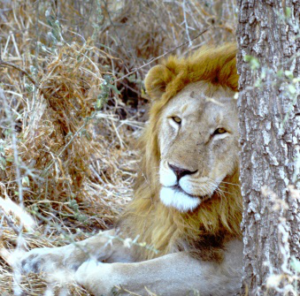
My next chance to see another of the big cats on my wish list involved some arduous travel. However, as I journeyed to Tanzania in east Africa, a nagging worry had begun to inject itself into my thoughts. After years of seeing Africa through the eyes of National Geographic and Animal Planet a certain image had been implanted in my mind. The Africa I pictured was one of immense vistas and vast grasslands populated by wildebeest, gazelles, zebra, and of course – lions. Wilderness, remoteness, and isolation from other humans were components of this image. My fear was that the reality just couldn’t measure up to my expectations. Exactly what would I find there?
As we sped northward, our Land Rover traversed Africa’s notoriously irregular, unpaved secondary roads. In some places, the road bore on in an arrow-straight line over miles of washboard. Our driver, Lawrence, hurried over these stretches of road as though he was negotiating the smoothest of asphalt. Curiously enough, speeding over these endless bumps did seem to impart a tolerable, harmonic vibration to our ride. In other places, a substantial washout had removed the original roadbed and intrepid drivers had constructed a new path through the surrounding bush. As we drove further and further from the city of Arusha, the feeling of being far removed from society grew. Passing an overturned vehicle I wondered how, and from where, one might expect to receive help should such an accident befall. Here in the United States, most of us are only minutes from the nearest hospital. In the developing countries of the world, the situation is far different and accidents can have much more dire conclusions.
Upon arriving in Serengeti National Park, my fears of encountering a diminished African wild evaporated. The Serengeti was everything I had 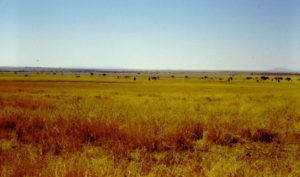 hoped it to be. Flat as a billiard table, the terrain stretched away miles to the far horizon broken only by occasional acacia trees and sporadic, mounded rock outcrops known as kopjes. This was the dry season and the landscape was a a ceaseless expanse of brownish grasses extending as far as the eye could see.
hoped it to be. Flat as a billiard table, the terrain stretched away miles to the far horizon broken only by occasional acacia trees and sporadic, mounded rock outcrops known as kopjes. This was the dry season and the landscape was a a ceaseless expanse of brownish grasses extending as far as the eye could see.
As anyone would be when visiting a new land, we were hopeful of meeting 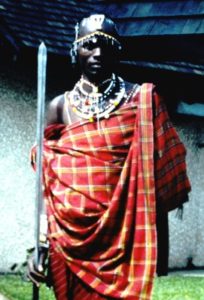 some of the human residents of the Serengeti. Here we were in luck, for shortly after entering this land of broad vistas we came upon a small Masai village. What a striking, fascinating people they were! Proud of their role as masters of these vast plains, the Masai exuded a palpable self-confidence. They have also become wise to the ways of western commerce. Photographs and village visits were not free. But unlike some tribal people who have been degraded by their exposure to money, these folks simply stated their fee (take it or leave it) and maintained a quiet dignity in so doing. Entry fee negotiated, the socializing was carried out in a most cordial manner.
some of the human residents of the Serengeti. Here we were in luck, for shortly after entering this land of broad vistas we came upon a small Masai village. What a striking, fascinating people they were! Proud of their role as masters of these vast plains, the Masai exuded a palpable self-confidence. They have also become wise to the ways of western commerce. Photographs and village visits were not free. But unlike some tribal people who have been degraded by their exposure to money, these folks simply stated their fee (take it or leave it) and maintained a quiet dignity in so doing. Entry fee negotiated, the socializing was carried out in a most cordial manner.
The Masai believe that Ngai (God) has given them title to all the cattle in their world. These animals, along with goats, form the core of Masai 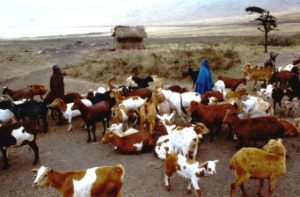 agriculture and economics. Their bomas (villages) are typical surrounded by a stout, thorn fence into which the cattle are herded at night; a necessity in a land of fearsome predators. The occasional calf needing special attention may share a family’s small hut which is called an enkaji.
agriculture and economics. Their bomas (villages) are typical surrounded by a stout, thorn fence into which the cattle are herded at night; a necessity in a land of fearsome predators. The occasional calf needing special attention may share a family’s small hut which is called an enkaji.
Curiously enough, by our standards, the enkaji is constructed by the woman of the house. She first sets poles into the ground and around these small saplings are woven to form a framework for the walls and roof. These are plastered with a mixture of mud and and cow dung. Such construction does  make for an extremely dark interior since there are no windows. Cooking is done on an open fire within the enkaji. Smoke escapes through the roof, but the interior is quite noticeably hazy and somewhat stifling. Very dark, exceedingly small, smoke-filled: these are my remembered impression of a Masai home. Yet, in spite of the absence of essentially every modern convenience we seem unable to do without, familial closeness, happiness, and contentment were palpably present. Over the years, I have been granted the boon of communion with many other cultures: the Temuan, the Riberenos, the Embera, the Yagua for example. As with the Masai, I always came away thinking that an exceedingly important lesson had been bestowed upon me. Perhaps it is we who need to reevaluate our priorities in order to maintain family contiguity and achieve contentment in our lives?
make for an extremely dark interior since there are no windows. Cooking is done on an open fire within the enkaji. Smoke escapes through the roof, but the interior is quite noticeably hazy and somewhat stifling. Very dark, exceedingly small, smoke-filled: these are my remembered impression of a Masai home. Yet, in spite of the absence of essentially every modern convenience we seem unable to do without, familial closeness, happiness, and contentment were palpably present. Over the years, I have been granted the boon of communion with many other cultures: the Temuan, the Riberenos, the Embera, the Yagua for example. As with the Masai, I always came away thinking that an exceedingly important lesson had been bestowed upon me. Perhaps it is we who need to reevaluate our priorities in order to maintain family contiguity and achieve contentment in our lives?
Our arrival preceded by a few weeks the large-scale migration of the great throngs of African grazing animals. During the year, massive herds 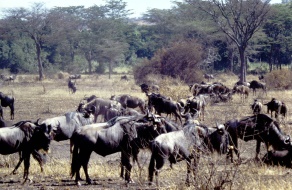 (wildebeest in particular)roam from the southern Serengeti northeastward toward the Masai Mara of Kenya. Over a period of months their clockwise migration will bring them back into the southern Serengeti again. Nevertheless, the plains were dotted with non-migratory wildebeest as well as Thompson’s gazelle, Burchell’s zebra, impala, and wart hogs. All thrilled us and confirmed that her
(wildebeest in particular)roam from the southern Serengeti northeastward toward the Masai Mara of Kenya. Over a period of months their clockwise migration will bring them back into the southern Serengeti again. Nevertheless, the plains were dotted with non-migratory wildebeest as well as Thompson’s gazelle, Burchell’s zebra, impala, and wart hogs. All thrilled us and confirmed that her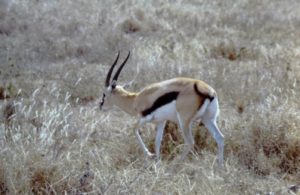 e was the Africa of our imaginings.
e was the Africa of our imaginings.
It was our habit to make a morning and an evening game drive in the Land Rover. What might appear around the next corner was always greatly anticipated. It could be a mixed herd of grazing wildebeest and zebras that we encountered. It might be a crowd of impalas resting in the shade of an acacia thicket. Thompson’s gazelles seemed to be everywhere. Once, driving along the edge of a grove of yellow acacia, we were rewarded with the sight of a leopard lying in repose on a lower, horizontal branch of one of the trees. Resting here in the shade, and surveying its domain, the leopard’s pose was a classic postcard of east Africa. The birding was fascinating with sightings of dozens of new and to our eyes exotic species: secretary birds, ground hornbills, bare-necked spurfowl, Griffon vultures, bataleur eagles, go-away-birds, weaver birds, and bustards.
And finally, there were lions. Descending a declivity in the track we were following, we noticed that water had collected in a basin adjacent to the 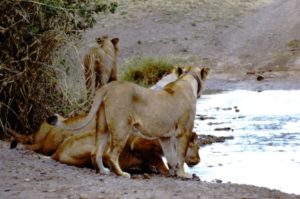 road. Waterholes are key places to look for wildlife. We eagerly scanned the area and were rewarded with the sight of six lionesses lounging beside the water. In fact, as we were to discover, this is what one observes lions doing most of the time. They typically spend over eighty percent of their day resting or sleeping. Nevertheless, we were at last seeing lions and I was well satisfied to see them even in repose. Several things struck me as I gazed, from just a few yards away, at my first wild lions. The size of these cats was impressive. Lions such as the ones we were looking upon weighed around three hundred pounds and stood three feet tall at the shoulder. The second physical feature which was so arresting was how well these lions blended with their surroundings. I suppose because of previously seeing lions only in documentaries, in which the camera is solely focused upon them, I had imagined them as being more
road. Waterholes are key places to look for wildlife. We eagerly scanned the area and were rewarded with the sight of six lionesses lounging beside the water. In fact, as we were to discover, this is what one observes lions doing most of the time. They typically spend over eighty percent of their day resting or sleeping. Nevertheless, we were at last seeing lions and I was well satisfied to see them even in repose. Several things struck me as I gazed, from just a few yards away, at my first wild lions. The size of these cats was impressive. Lions such as the ones we were looking upon weighed around three hundred pounds and stood three feet tall at the shoulder. The second physical feature which was so arresting was how well these lions blended with their surroundings. I suppose because of previously seeing lions only in documentaries, in which the camera is solely focused upon them, I had imagined them as being more  detectable. Now, as I watched the resting cats, two more emerged from the grasses surrounding the waterhole. It wasn’t until they had almost fully stepped out into the open that they were really noticeable. Their tawny color was laid upon a matte finish of satin-like fur. Their hue matched that of the grasses to such an extent that they were rendered practically invisible. Considering that the majority of their prey species are colorblind, it was little wonder that these big cats could so stealthily and so closely approach them before launching their explosive, final attack. It was easy to imagine how hunting lionesses may work cooperatively to stampede an antelope right into the jaws of a pride-mate stealthily lying in ambush.
detectable. Now, as I watched the resting cats, two more emerged from the grasses surrounding the waterhole. It wasn’t until they had almost fully stepped out into the open that they were really noticeable. Their tawny color was laid upon a matte finish of satin-like fur. Their hue matched that of the grasses to such an extent that they were rendered practically invisible. Considering that the majority of their prey species are colorblind, it was little wonder that these big cats could so stealthily and so closely approach them before launching their explosive, final attack. It was easy to imagine how hunting lionesses may work cooperatively to stampede an antelope right into the jaws of a pride-mate stealthily lying in ambush.
And then there were the eyes; fixed upon us in alertness, the dozen eyes were commanding. As I gazed back at those clear, crystal pools of yellowish-brown I was mesmerized. What message did they convey? There was no hint of recognizable emotion , no sign of the friendly “I’m glad your home” look one sees in the eyes of a faithful canine companion. I saw no suggestion of a deep intelligence as one might see mirrored in the eyes of an aged pachyderm matriarch. Instead these eyes were ablaze with a deeply penetrating wildness. They were cold as Arctic ice, piercing, and untamed. It seemed such stares could penetrate my body like the pulsed probings of an MRI machine. I could easily imagine the effectiveness with which these big cats thus analyzed a herd of antelopes as they looked for a straggler, a herd member with a limping gait, an animal marked by age or disease. Abruptly a discomfort flashed fleetingly, deeply in my sub-conscious. I recognized it as the ancient, inherited fear of prey confronted by predator. It was profoundly unnerving.
Though the lionesses we saw at the waterhole were resting and misleadingly inoffensive, we were later to experience the vicious hunting prowess of these cats. Our first encounter with what one these big felines 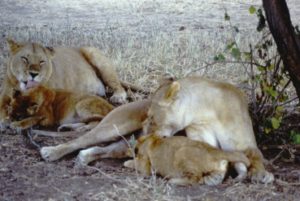 could do occurred as we rounded a corner on a morning game drive. Lying partially on the roadside was a dead zebra. A large zebra may weigh eight hundred pounds, a weight equivalent to several large men. But this mass coupled with great strength had been no match for its attacker. Along its hip was an incision which looked as though it had been surgically made with a giant scalpel. The length and the depth of the wound were frightening in their savagery. A claw four inches long, with a razor sharp tip, had done this. Tell-tale bite marks around the zebra’s throat confirmed that this was the work of a lion. A lion that was very likely lying nearby, unseen but guarding its freshly acquired kill. On other occasions we observed zebras with long, parallel, healed scars on each hip. These were animals that had also been attacked by lions. The big cats had made their characteristic leap onto the hindquarters of the zebra and the scars told of a desperate flight and a narrow escape. I could not help but ponder whether the zebra would be so lucky the next time. Nor could I avoid the empathetic, and perhaps anthropomorphic, consideration of how extraordinarily stressful it might be for a prey animal to live in such a constant state of apprehension and preparedness for flight.
could do occurred as we rounded a corner on a morning game drive. Lying partially on the roadside was a dead zebra. A large zebra may weigh eight hundred pounds, a weight equivalent to several large men. But this mass coupled with great strength had been no match for its attacker. Along its hip was an incision which looked as though it had been surgically made with a giant scalpel. The length and the depth of the wound were frightening in their savagery. A claw four inches long, with a razor sharp tip, had done this. Tell-tale bite marks around the zebra’s throat confirmed that this was the work of a lion. A lion that was very likely lying nearby, unseen but guarding its freshly acquired kill. On other occasions we observed zebras with long, parallel, healed scars on each hip. These were animals that had also been attacked by lions. The big cats had made their characteristic leap onto the hindquarters of the zebra and the scars told of a desperate flight and a narrow escape. I could not help but ponder whether the zebra would be so lucky the next time. Nor could I avoid the empathetic, and perhaps anthropomorphic, consideration of how extraordinarily stressful it might be for a prey animal to live in such a constant state of apprehension and preparedness for flight.
Once we pulled our Land Rover up to a big male lion who was feeding on what remained of a wart hog. All the members of the cat family, including house cats, have jaw teeth which are known as carnassials. These are 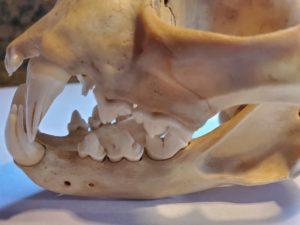 formed by the upper premolar teeth and the first molar teeth of the lower jaw. Carnassial teeth are evolutionarily modified to shear. They are high-crowned teeth which have a cross-sectional shape very much like that of a scissors’ blades. The sharp, flattened edge of an upper carnassial slides over the equally sharp, abruptly-edged lower molar imparting a shearing force to their bite. This is why you may have seen your domestic cat, when tackling a particularly tough piece of food, tilt its head to the side and engage the food item with its lateral jaw teeth. As we watched the big male dine on the wart hog, he did just that. Taking a stout leg bone into his mouth, the lion tilted his head to the side and brought the bone into a position between his carnassial teeth. With a sudden, loud pop the bone was sheared into two as easily as we might bite through a hot dog. There was a synchronized cry of surprise from our group as everyone reacted to this display of the tremendous power held in those fearsome jaws.
formed by the upper premolar teeth and the first molar teeth of the lower jaw. Carnassial teeth are evolutionarily modified to shear. They are high-crowned teeth which have a cross-sectional shape very much like that of a scissors’ blades. The sharp, flattened edge of an upper carnassial slides over the equally sharp, abruptly-edged lower molar imparting a shearing force to their bite. This is why you may have seen your domestic cat, when tackling a particularly tough piece of food, tilt its head to the side and engage the food item with its lateral jaw teeth. As we watched the big male dine on the wart hog, he did just that. Taking a stout leg bone into his mouth, the lion tilted his head to the side and brought the bone into a position between his carnassial teeth. With a sudden, loud pop the bone was sheared into two as easily as we might bite through a hot dog. There was a synchronized cry of surprise from our group as everyone reacted to this display of the tremendous power held in those fearsome jaws.
Our last encounter with a group of feeding lions occurred in another of Tanzania’s wonderful national parks – Ngorongoro. Part of a large conservation area, Ngorongoro itself is a caldera or collapsed volcanic crater some ten to twelve miles in diameter. At its center lies a large area of shallow water known as Lake Magadi. As we cruised along within the great caldera and neared the lake, we saw a group of lions near the shore. As we came closer, we saw that they were females with cubs. Some were resting, as usual, but another seemed to be tugging at something in the water. When we finally arrived upon the scene, we discovered a scene of carnage. A group of lions had killed eleven wildebeest in one savage foray during the previous night. The lions had apparently driven the fear-crazed wildebeest into the mud at the edge of the lake. Here the antelopes had become mired in the muck, floundered, and been set upon by the pride. Most of the wildebeests had been devoured and only scraps of hide and bone remained to be counted. But the carcasses of two of the animals still lay intact but half buried in the mud. A lioness was endeavoring to pull one of these free in order to resume feeding. This was the tugging exercise we had seen from a distance. The cubs alternately romped with each other or came to the Land Rover to rear up on it and investigate the strange object. Most of the lionesses were at rest from their work and casually watched their offspring’s activities. Any males that may have been involved had moved off to a place of solitude. Absent the remains of the wildebeest, the scene might have been one of quiet, social harmony.
But it really was difficult to ignore the remnants of so many prey animals. Additionally, the air remained laden with the powerful, sweet, metallic odor of blood. This aroma was mixed with the sulfurous smell of churned mud, 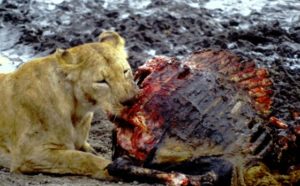 the scent of wildebeest stomach contents lying spilled upon the mud, and the strong essence of urine voided by the fear-crazed antelopes. One could not help but imagine the wild violence, the savage growls, the frantic grunting, the slashing claws, the gory feasting that had taken place here only hours before. The scene was one of unadulterated savagery. Never again would I naively look upon a tableau of the east African plains as pastoral and benign.
the scent of wildebeest stomach contents lying spilled upon the mud, and the strong essence of urine voided by the fear-crazed antelopes. One could not help but imagine the wild violence, the savage growls, the frantic grunting, the slashing claws, the gory feasting that had taken place here only hours before. The scene was one of unadulterated savagery. Never again would I naively look upon a tableau of the east African plains as pastoral and benign.
And so at last I was able to frame from familiarity an enduring mental picture of lions. They could at times be so placid, so seemingly innocuous. The females were capable of directing such tenderness and attentiveness to their young. But one only needed a few days in lion country to understand the ferocious strength, the superlative stealth, the pure ferocity that resided just beneath the surface. A million years of evolutionary adaptation directed toward preying upon large herbivores – yes, I now had an exceedingly good appreciation of what that looked like.
